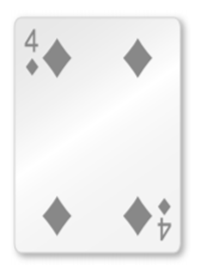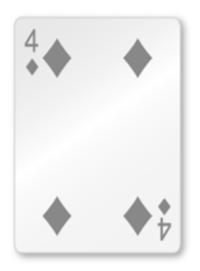
BIG IDEAS MATH Integrated Math 1: Student Edition 2016
16th Edition
ISBN: 9781680331127
Author: HOUGHTON MIFFLIN HARCOURT
Publisher: Houghton Mifflin Harcourt
expand_more
expand_more
format_list_bulleted
Question
Chapter 11, Problem 13CT
To determine
To find: Whether the object has line symmetry and whether it has rotational symmetry.
Expert Solution & Answer
Answer to Problem 13CT
The given figure has no rotational symmetry.
Explanation of Solution
Given information: The Figure is shown below.

Calculation:
The graph is shown below.

Figure-1
The above figure has no line of symmetry.
A figure in a plan has rotational symmetry when the figure cannot be mapped itself by a rotation of 180 degrees or less about center.
Thus, the given figure has no rotational symmetry.
Chapter 11 Solutions
BIG IDEAS MATH Integrated Math 1: Student Edition 2016
Ch. 11.1 - Prob. 1ECh. 11.1 - Prob. 2ECh. 11.1 - Prob. 3ECh. 11.1 - Prob. 4ECh. 11.1 - Prob. 5ECh. 11.1 - Prob. 6ECh. 11.1 - Prob. 7ECh. 11.1 - Prob. 8ECh. 11.1 - Prob. 9ECh. 11.1 - Prob. 10E
Ch. 11.1 - Prob. 11ECh. 11.1 - Prob. 12ECh. 11.1 - Prob. 13ECh. 11.1 - Prob. 14ECh. 11.1 - Prob. 15ECh. 11.1 - Prob. 16ECh. 11.1 - Prob. 17ECh. 11.1 - Prob. 18ECh. 11.1 - Prob. 19ECh. 11.1 - Prob. 20ECh. 11.1 - Prob. 21ECh. 11.1 - Prob. 22ECh. 11.1 - Prob. 23ECh. 11.1 - Prob. 24ECh. 11.1 - Prob. 25ECh. 11.1 - Prob. 26ECh. 11.1 - Prob. 27ECh. 11.1 - Prob. 28ECh. 11.1 - Prob. 29ECh. 11.1 - Prob. 30ECh. 11.1 - Prob. 31ECh. 11.1 - Prob. 32ECh. 11.1 - Prob. 33ECh. 11.1 - Prob. 34ECh. 11.1 - Prob. 35ECh. 11.1 - Prob. 36ECh. 11.1 - Prob. 37ECh. 11.1 - Prob. 38ECh. 11.1 - Prob. 39ECh. 11.1 - Prob. 40ECh. 11.1 - Prob. 41ECh. 11.1 - Prob. 42ECh. 11.1 - Prob. 43ECh. 11.1 - Prob. 44ECh. 11.1 - Prob. 45ECh. 11.1 - Prob. 46ECh. 11.1 - Prob. 47ECh. 11.1 - Prob. 48ECh. 11.1 - Prob. 49ECh. 11.1 - Prob. 50ECh. 11.2 - Prob. 1ECh. 11.2 - Prob. 2ECh. 11.2 - Prob. 3ECh. 11.2 - Prob. 4ECh. 11.2 - Prob. 5ECh. 11.2 - Prob. 6ECh. 11.2 - Prob. 7ECh. 11.2 - Prob. 8ECh. 11.2 - Prob. 9ECh. 11.2 - Prob. 10ECh. 11.2 - Prob. 11ECh. 11.2 - Prob. 12ECh. 11.2 - Prob. 13ECh. 11.2 - Prob. 14ECh. 11.2 - Prob. 15ECh. 11.2 - Prob. 16ECh. 11.2 - Prob. 17ECh. 11.2 - Prob. 18ECh. 11.2 - Prob. 19ECh. 11.2 - Prob. 20ECh. 11.2 - Prob. 21ECh. 11.2 - Prob. 22ECh. 11.2 - Prob. 23ECh. 11.2 - Prob. 24ECh. 11.2 - Prob. 25ECh. 11.2 - Prob. 26ECh. 11.2 - Prob. 27ECh. 11.2 - Prob. 28ECh. 11.2 - Prob. 29ECh. 11.2 - Prob. 30ECh. 11.2 - Prob. 31ECh. 11.2 - Prob. 32ECh. 11.2 - Prob. 33ECh. 11.2 - Prob. 34ECh. 11.2 - Prob. 35ECh. 11.2 - Prob. 36ECh. 11.2 - Prob. 37ECh. 11.2 - Prob. 38ECh. 11.2 - Prob. 39ECh. 11.2 - Prob. 40ECh. 11.2 - Prob. 41ECh. 11.2 - Prob. 42ECh. 11.2 - Prob. 43ECh. 11.2 - Prob. 44ECh. 11.2 - Prob. 45ECh. 11.2 - Prob. 46ECh. 11.2 - Prob. 47ECh. 11.2 - Prob. 48ECh. 11.2 - Prob. 49ECh. 11.2 - Prob. 1QCh. 11.2 - Prob. 2QCh. 11.2 - Prob. 3QCh. 11.2 - Prob. 4QCh. 11.2 - Prob. 5QCh. 11.2 - Prob. 6QCh. 11.2 - Prob. 7QCh. 11.2 - Prob. 8QCh. 11.2 - Prob. 9QCh. 11.2 - Prob. 10QCh. 11.2 - Prob. 11QCh. 11.2 - Prob. 12QCh. 11.2 - Prob. 13QCh. 11.2 - Prob. 14QCh. 11.2 - Prob. 15QCh. 11.2 - Prob. 16QCh. 11.2 - Prob. 17QCh. 11.2 - Prob. 18QCh. 11.2 - Prob. 19QCh. 11.3 - Prob. 1ECh. 11.3 - Prob. 2ECh. 11.3 - Prob. 3ECh. 11.3 - Prob. 4ECh. 11.3 - Prob. 5ECh. 11.3 - Prob. 6ECh. 11.3 - Prob. 7ECh. 11.3 - Prob. 8ECh. 11.3 - Prob. 9ECh. 11.3 - Prob. 10ECh. 11.3 - Prob. 11ECh. 11.3 - Prob. 12ECh. 11.3 - Prob. 13ECh. 11.3 - Prob. 14ECh. 11.3 - Prob. 15ECh. 11.3 - Prob. 16ECh. 11.3 - Prob. 17ECh. 11.3 - Prob. 18ECh. 11.3 - Prob. 19ECh. 11.3 - Prob. 20ECh. 11.3 - Prob. 21ECh. 11.3 - Prob. 22ECh. 11.3 - Prob. 23ECh. 11.3 - Prob. 24ECh. 11.3 - Prob. 25ECh. 11.3 - Prob. 26ECh. 11.3 - Prob. 27ECh. 11.3 - Prob. 28ECh. 11.3 - Prob. 29ECh. 11.3 - Prob. 30ECh. 11.3 - Prob. 31ECh. 11.3 - Prob. 32ECh. 11.3 - Prob. 33ECh. 11.3 - Prob. 34ECh. 11.3 - Prob. 35ECh. 11.3 - Prob. 36ECh. 11.3 - Prob. 37ECh. 11.3 - Prob. 38ECh. 11.3 - Prob. 39ECh. 11.3 - Prob. 40ECh. 11.3 - Prob. 41ECh. 11.4 - Prob. 1ECh. 11.4 - Prob. 2ECh. 11.4 - Prob. 3ECh. 11.4 - Prob. 4ECh. 11.4 - Prob. 5ECh. 11.4 - Prob. 6ECh. 11.4 - Prob. 7ECh. 11.4 - Prob. 8ECh. 11.4 - Prob. 9ECh. 11.4 - Prob. 10ECh. 11.4 - Prob. 11ECh. 11.4 - Prob. 12ECh. 11.4 - Prob. 13ECh. 11.4 - Prob. 14ECh. 11.4 - Prob. 15ECh. 11.4 - Prob. 16ECh. 11.4 - Prob. 17ECh. 11.4 - Prob. 18ECh. 11.4 - Prob. 19ECh. 11.4 - Prob. 20ECh. 11.4 - Prob. 21ECh. 11.4 - Prob. 22ECh. 11.4 - Prob. 23ECh. 11.4 - Prob. 24ECh. 11.4 - Prob. 25ECh. 11.4 - Prob. 26ECh. 11.4 - Prob. 27ECh. 11.4 - Prob. 28ECh. 11.4 - Prob. 29ECh. 11.4 - Prob. 30ECh. 11.4 - Prob. 31ECh. 11.4 - Prob. 32ECh. 11.4 - Prob. 33ECh. 11.4 - Prob. 34ECh. 11.4 - Prob. 35ECh. 11.4 - Prob. 36ECh. 11.4 - Prob. 37ECh. 11.4 - Prob. 38ECh. 11.4 - Prob. 39ECh. 11.4 - Prob. 40ECh. 11.4 - Prob. 41ECh. 11.4 - Prob. 42ECh. 11.4 - Prob. 43ECh. 11 - Prob. 1CRCh. 11 - Prob. 2CRCh. 11 - Prob. 3CRCh. 11 - Prob. 4CRCh. 11 - Prob. 5CRCh. 11 - Prob. 6CRCh. 11 - Prob. 7CRCh. 11 - Prob. 8CRCh. 11 - Prob. 9CRCh. 11 - Prob. 10CRCh. 11 - Prob. 11CRCh. 11 - Prob. 12CRCh. 11 - Prob. 13CRCh. 11 - Prob. 14CRCh. 11 - Prob. 15CRCh. 11 - Prob. 16CRCh. 11 - Prob. 17CRCh. 11 - Prob. 18CRCh. 11 - Prob. 19CRCh. 11 - Prob. 20CRCh. 11 - Prob. 21CRCh. 11 - Prob. 22CRCh. 11 - Prob. 23CRCh. 11 - Prob. 24CRCh. 11 - Prob. 1CTCh. 11 - Prob. 2CTCh. 11 - Prob. 3CTCh. 11 - Prob. 4CTCh. 11 - Prob. 5CTCh. 11 - Prob. 6CTCh. 11 - Prob. 7CTCh. 11 - Prob. 8CTCh. 11 - Prob. 9CTCh. 11 - Prob. 10CTCh. 11 - Prob. 11CTCh. 11 - Prob. 12CTCh. 11 - Prob. 13CTCh. 11 - Prob. 14CTCh. 11 - Prob. 15CTCh. 11 - Prob. 16CTCh. 11 - Prob. 17CTCh. 11 - Prob. 18CTCh. 11 - Prob. 1CACh. 11 - Prob. 2CACh. 11 - Prob. 3CACh. 11 - Prob. 4CACh. 11 - Prob. 5CACh. 11 - Prob. 6CACh. 11 - Prob. 7CACh. 11 - Prob. 8CACh. 11 - Prob. 9CACh. 11 - Prob. 10CA
Knowledge Booster
Similar questions
- Topic 2 Evaluate S x dx, using u-substitution. Then find the integral using 1-x2 trigonometric substitution. Discuss the results! Topic 3 Explain what an elementary anti-derivative is. Then consider the following ex integrals: fed dx x 1 Sdx In x Joseph Liouville proved that the first integral does not have an elementary anti- derivative Use this fact to prove that the second integral does not have an elementary anti-derivative. (hint: use an appropriate u-substitution!)arrow_forward1. Given the vector field F(x, y, z) = -xi, verify the relation 1 V.F(0,0,0) = lim 0+ volume inside Se ff F• Nds SE where SE is the surface enclosing a cube centred at the origin and having edges of length 2€. Then, determine if the origin is sink or source.arrow_forward4 3 2 -5 4-3 -2 -1 1 2 3 4 5 12 23 -4 The function graphed above is: Increasing on the interval(s) Decreasing on the interval(s)arrow_forward
- Question 4 The plot below represents the function f(x) 8 7 3 pts O -4-3-2-1 6 5 4 3 2 + 1 2 3 5 -2+ Evaluate f(3) f(3) = Solve f(x) = 3 x= Question 5arrow_forwardQuestion 14 6+ 5 4 3 2 -8-2 2 3 4 5 6 + 2 3 4 -5 -6 The graph above is a transformation of the function f(x) = |x| Write an equation for the function graphed above g(x) =arrow_forwardQuestion 8 Use the graph of f to evaluate the following: 6 f(x) 5 4 3 2 1 -1 1 2 3 4 5 -1 t The average rate of change of f from 4 to 5 = Question 9 10 ☑ 4parrow_forward
- Question 15 ✓ 6 pts 1 Details The function shown below is f(x). We are interested in the transformed function g(x) = 3f(2x) - 1 a) Describe all the transformations g(x) has made to f(x) (shifts, stretches, etc). b) NEATLY sketch the transformed function g(x) and upload your graph as a PDF document below. You may use graph paper if you want. Be sure to label your vertical and horizontal scales so that I can tell how big your function is. 1- 0 2 3 4 -1- Choose File No file chosen Question 16 0 pts 1 Detailsarrow_forwardAND B A Ꭰarrow_forwardANBNC ND B こ Ꭰarrow_forward
- 1 Matching 10 points Factor and Solve 1)x3-216 0, x = {6,[B]} 2) 16x3 = 54 x-[3/2,[D]] 3)x4x2-42 0 x= [ +/-isqrt(7), [F] } 4)x+3-13-9x x=[+/-1.[H]] 5)x38x2+16x=0, x = {0,[K}} 6) 2x6-10x-48x2-0 x-[0, [M], +/-isqrt(3)) 7) 3x+2x²-8 x = {+/-i sqrt(2), {Q}} 8) 5x³-3x²+32x=2x+18 x = {3/5, [S]} [B] [D] [F] [H] [K] [M] [Q] +/-2 sqrt(2) +/- i sqrt(6) (-3+/-3 i sqrt(3))/4 +/- 1 +/-sqrt(6) +/- 2/3 sqrt(3) 4 -3 +/- 3 i sqrt(3) [S]arrow_forwardD U(AUBUC) B Darrow_forwardhelparrow_forward
arrow_back_ios
SEE MORE QUESTIONS
arrow_forward_ios
Recommended textbooks for you
 Discrete Mathematics and Its Applications ( 8th I...MathISBN:9781259676512Author:Kenneth H RosenPublisher:McGraw-Hill Education
Discrete Mathematics and Its Applications ( 8th I...MathISBN:9781259676512Author:Kenneth H RosenPublisher:McGraw-Hill Education Mathematics for Elementary Teachers with Activiti...MathISBN:9780134392790Author:Beckmann, SybillaPublisher:PEARSON
Mathematics for Elementary Teachers with Activiti...MathISBN:9780134392790Author:Beckmann, SybillaPublisher:PEARSON
 Thinking Mathematically (7th Edition)MathISBN:9780134683713Author:Robert F. BlitzerPublisher:PEARSON
Thinking Mathematically (7th Edition)MathISBN:9780134683713Author:Robert F. BlitzerPublisher:PEARSON Discrete Mathematics With ApplicationsMathISBN:9781337694193Author:EPP, Susanna S.Publisher:Cengage Learning,
Discrete Mathematics With ApplicationsMathISBN:9781337694193Author:EPP, Susanna S.Publisher:Cengage Learning, Pathways To Math Literacy (looseleaf)MathISBN:9781259985607Author:David Sobecki Professor, Brian A. MercerPublisher:McGraw-Hill Education
Pathways To Math Literacy (looseleaf)MathISBN:9781259985607Author:David Sobecki Professor, Brian A. MercerPublisher:McGraw-Hill Education

Discrete Mathematics and Its Applications ( 8th I...
Math
ISBN:9781259676512
Author:Kenneth H Rosen
Publisher:McGraw-Hill Education

Mathematics for Elementary Teachers with Activiti...
Math
ISBN:9780134392790
Author:Beckmann, Sybilla
Publisher:PEARSON


Thinking Mathematically (7th Edition)
Math
ISBN:9780134683713
Author:Robert F. Blitzer
Publisher:PEARSON

Discrete Mathematics With Applications
Math
ISBN:9781337694193
Author:EPP, Susanna S.
Publisher:Cengage Learning,

Pathways To Math Literacy (looseleaf)
Math
ISBN:9781259985607
Author:David Sobecki Professor, Brian A. Mercer
Publisher:McGraw-Hill Education